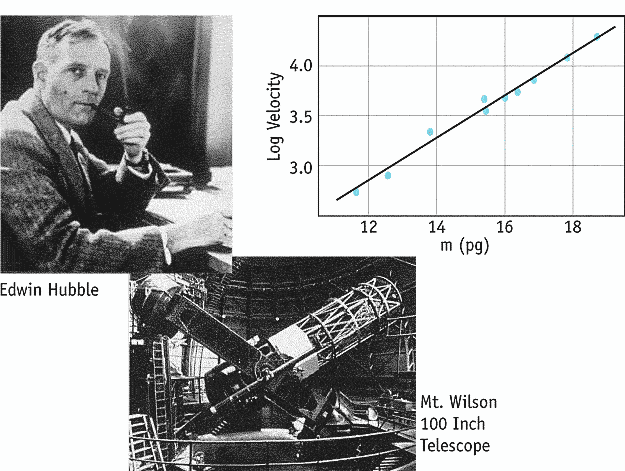
With the discovery that spiral nebula were, in fact, other galaxies external to our own, our concept of a Universe became one of in a Newtonian universe of infinite size and mass, galaxies spread out in infinite space. However, there is a problem with a uniform, static Universe, any density enhancements would become unstable to gravitational collapse. Thus, the whole Universe should have collapsed (or be collapsing) into a giant black hole.
In the 1930's, Edwin Hubble discovered that all galaxies have a positive redshift. In other words, all galaxies were receding from the Milky Way. By the Copernican principle (we are not at a special place in the Universe), we deduce that all galaxies are receding from each other, or we live in a dynamic, expanding Universe. This solves the problem for gravitational collapse, only small regions will collapse to form galaxies. The rest of space keeps expanding.

The expansion of the Universe is described by a very simple equation called Hubble's law; the velocity of the recession of a galaxy (determined from its redshift, see below) is equal to a constant times its distance (v=Hd). Where the constant is called Hubble's constant and relates distance to velocity in units of megaparsecs (millions of parsecs).
Redshift:
The key observable in extragalactic studies is the redshift of a distant galaxy. All galaxies are made of stars which emit a spectrum of electromagnetic radiation with particular fingerprint-like patterns corresponding to the quantum shells of the various elements in the star's atmospheres. The lines of hydrogen, magnesium and calcium are particularly prominate in galaxies, and can be identified with telescopes using a special instrument called a spectrograph.

A typical galaxy spectrum is shown above where the emission from the galaxy's core (3) is in the center. Also seen in the image are emission lines from the earth's night sky (2), the effects of cosmic rays (5) and a nearby star (6) appear as lines parallel to the core's trace. Dynamics and kinematics of the galaxy are hidden in some wormlike structures (1).
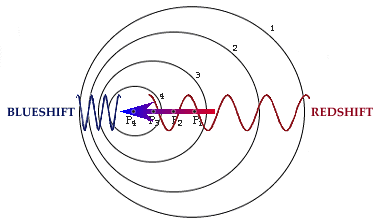
The velocity of a galaxy is measured by the Doppler effect, the fact that light emitted from a source is shifted in wavelength by the motion of the source. The change in wavelength, with respect to the source at rest, is called the redshift (if moving away, blueshift if moving towards the observer) and is denoted by the letter z. Redshift, z, is proportional to the velocity of the galaxy divided by the speed of light. Since all galaxies display a redshift, i.e. moving away from us, this is referred to as recession velocity.

You can see the Doppler effect in a rotating galaxy spectrum (a zoom-in above), where one side of an edge-on rotating disk is coming towards us, and the other side of moving away. The moving away side is redshifted, a little bit, and otherside is blueshifted, a little bit. So in the image above, the top part of the emission line is shifted to the red (longer wavelengths), and the bottom is shifted to the blue (shorter wavelengths). Resulting in an S-shaped spectral feature.
Of course, a key parameter in understanding the distance-redshift relation is the calibration of the whole system. This is know as the problem of the extragalactic distance scale, an ongoing research project for the last 30 years. The primary goal of the distance scale project is to compare the redshift, or recession velocity, of a galaxy with some independent measure of its distance. This is, of course, much more difficult than one would natively think since we can not travel to nearby galaxies, and they are much too far away to observe their motion or parallax.
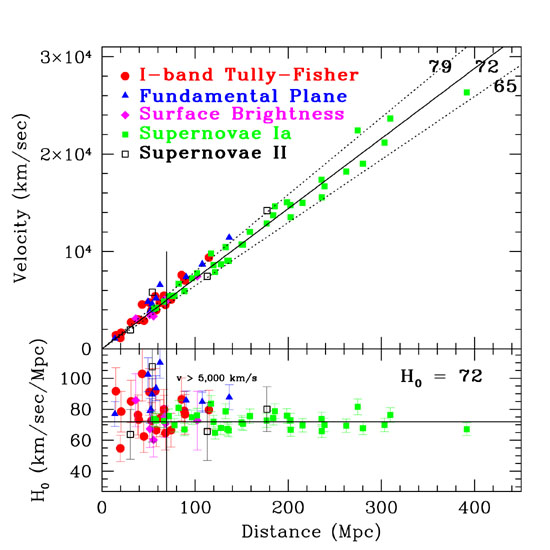
As a result, distance scale work uses a chain of distance indicators working outward from nearby stars to star clusters in our own Galaxy to stars in nearby galaxies. Unusually bright stars, such as variable stars and supernovae, complete the distance ladder out to cosmological distances. The latest results from the Hubble Space Telescope are shown above, a plot of recession velocity with distance (in megaparsecs, millions of light-years). The straight, linear correlation indicates that the Universe is currently expanding at a rate of 72 km per sec for every Mpc. The rate, known as Hubble's constant, may change with time (see next lecture).
Expanding Universe:
A common question in cosmology is "why are all the galaxies receding from each other?" In other words, the cosmological principle requires that we not be at a special place in the Universe. Since all the galaxies are moving away from us, then they must all be moving away from each other. This is explained if the Universe, as a whole, is expanding.
In a real sense, Hubble's law, the recession velocity of galaxies, is an illusion. The galaxies are not moving, the space between them is literally expanded. To see how this produces a Doppler effect, consider a simply Universe that is a circle. To the observers in this type of Universe, they believe they live in a 1D structure. But, in fact, they live in a 2D structure, a circle. The position of the galaxies can be measured by the distance between them (S, see diagram below) or what are called the co-moving coordinates, an angle θ between the galaxies.
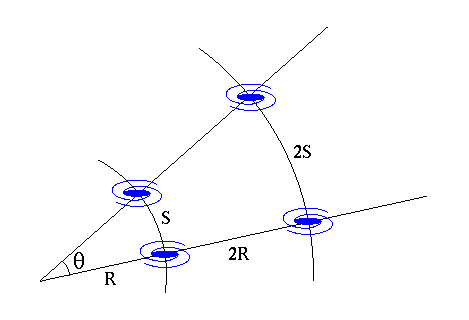
The radius of the Universe is given by R, notice that R is a quantity only seen in 2D space, not measured directly by the inhabitants of the 1D circle unless they measure 2πR by walking around the Universe. Now, we let the Universe expand by a factor of 2, R becomes 2R. The distance between the galaxies becomes 2S, but the co-moving coordinate, angle θ remains unchanged. Since the distance between the galaxies has increased, then the galaxies will appear to have moved apart by S/time of expansion. When, in fact, the galaxies have not moved at all, the space between them has increased.
Expanding spacetime also explains the redshift of galaxies, which is interpreted as Doppler motion. Since space expands, any photons traveling through that space (from distant galaxies to us) must also expand, i.e. the photons are `stretched' as they travel across the Universe.
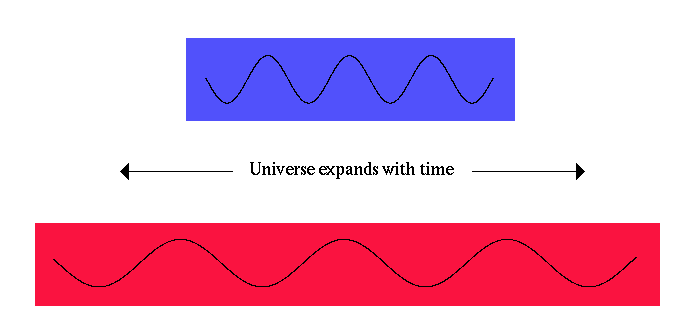
So the redshift we see for distant galaxies is really an effect of spacetime expanding, not real motion. This is good because some of the redshifts for the most distant galaxies have recessional velocities in excess to the speed of light. But this is not a contradiction for special relativity since the space is expanding, not true motion. We will also see that photons created as gamma rays in the early Universe are now redshifted to the microwave region of the spectrum to make up what is called the cosmic microwave background (CMB).